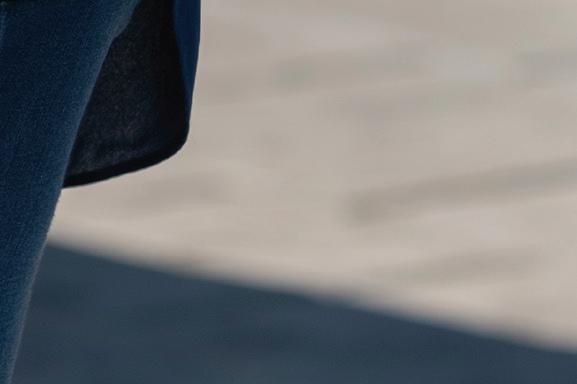
5 minute read
I’VE GAINED MY LIFE BACK.’ Total hip
Elizabeth Vega can walk and dance again after a total hip replacement at Jersey City Medical Center.





‘I’VE GAINED
MY LIFE BACK’




AFTER A TOTAL HIP REPLACEMENT, A WEST REPLACEMENT, A WEST NEW YORK WOMAN NEW YORK WOMAN IS ABLE TO WALK IS ABLE TO WALK WITHOUT PAIN.



Elizabeth Vega, 48, of West New York, loves to dance, especially salsa, and to take Zumba classes. However, in her early 40s, she began to experience hip pain while dancing. She went for a medical evaluation and was told by a doctor that she had arthritis and would eventually need to have one or both of her hips replaced.
“I continued with my life, but with time my hips started to limit my social life and athletic ability,” says Elizabeth, who works as Supervisor for Radiology Scheduling at the Barnabas Health Ambulatory Care Center in Livingston.
Arthritis like Elizabeth’s, also referred to as degenerative joint disease, is the prime cause of the breakdown of hip cartilage. Th e condition causes the bones in the hip joint to begin to rub against each other. It creates pain and stiff ness as well as deformities such as bone spurs.
It wasn’t until Elizabeth developed a limp, fell down the stairs at work and experienced limits to her walking that she seriously considered hip replacement, known as total hip arthroplasty.
NEXT STEPS
During total hip arthroplasty, a surgeon removes the damaged hip joint and replaces it with an artifi cial joint, oft en made from metal and plastic components. Th e procedure is designed to improve range of motion and function, and ease pain in a damaged hip. Th is surgery is recommended when severe pain and stiff ness limit activity, interfere with sleep and cannot be relieved by medication.
Elizabeth consulted with Richard Yoon, MD, a member of RWJBarnabas Health Medical Group and Director, Orthopedic Research at Jersey City Medical Center (JCMC), which Elizabeth chose due to its proximity to her West New York home. Formerly a physician herself in Colombia, Elizabeth admired Dr. Yoon’s demeanor and was impressed with his knowledge and professionalism. “I wanted to RICHARD YOON, MD be confi dent that
ANTERIOR HIP REPLACEMENT POSTERIOR HIP REPLACEMENT TWO APPROACHES TO HIP SURGERY:
The anterior approach, shown at left, is performed through an incision of 3 to 4 inches in the front of the hip and can be done without having to detach muscle from bone. The posterior approach, at right, is done from the side or back and requires a larger incision of 8 to 12 inches, cutting through muscle. “Either approach may be recommended, depending on a patient’s individual needs,” says Richard Yoon, MD, Director of Orthopedic Research at JCMC.
I could trust the physician who would do my surgery and that the surgeon had plenty of experience performing it with positive results,” she says.
Traditionally, surgeons have performed total hip arthroplasty using what’s known as the posterior approach, with an incision through the back of the hip. Th is method provides the surgeon with high visibility of the joint and precise implant placement.
For Elizabeth, however, Dr. Yoon recommended that her right hip be replaced using the anterior approach, in which an incision is made in front of the hip. Because it does not require that muscles and tendons be cut, this technique minimizes complications, aids rapid recovery and involves less pain.
“Th e anterior method is especially useful for active, younger patients like Liz who are eager to return to work and want a faster recovery,” Dr. Yoon explains, “but we also use it on older patients who want to remain active. Th e implants can last for 30 to 35 years.” Dr. Yoon also continues to use the posterior approach. “It’s easy to do and more suitable for patients who are obese or at higher risk due to conditions such as Parkinson’s, dementia or hip fracture,” he explains.
DANCING AGAIN
Elizabeth’s surgery was set for March, but due to COVID-19, it was rescheduled three times and fi nally performed in June. Despite the pandemic, Elizabeth felt protected and safe at JCMC, where all precautions were thoroughly explained to her. “Dr. Yoon and his staff provided excellent care and were helpful and knowledgeable,” she says.
Elizabeth had been worried that she might be in pain and unable to move aft er surgery, but she was pleasantly surprised. “I was walking the next day, and my pain was tolerable. My scar was also smaller than I thought,’’ she recalls. She underwent two weeks of physical therapy at home, then six weeks of outpatient therapy at JCMC. “Th ey are a great team, caring and passionate in promoting your recovery,” she says.
By six weeks aft er surgery, Elizabeth was surprised at how easy it had been to recover the strength and movement of her leg. “I have gained back my life. I walk a lot, which I could not do before,” she says. “I can dance and drive, and I’ve started to get back in shape and lose weight.”
Elizabeth has regular follow-up appointments with Dr. Yoon, who has continued to be a dedicated partner. “It’s been a big change from before to aft er. I feel amazing,” she says.
“Th is is the reason I went into surgery,” Dr. Yoon admits. “I had a patient—who previously couldn’t change her socks or walk without resting—come in to see me. She was no longer leaning on a cane and had a smile on her face.”
ORTHOPEDIC SERVICES CLOSE TO HOME
Jersey City Medical Center offers the latest diagnostic and surgical technologies for orthopedic patients at two convenient locations:
MEDICAL OFFICE BUILDING AT JERSEY CITY MEDICAL CENTER
377 Jersey Avenue, Suite 280-A, Jersey City
NEWPORT LOCATION
100 Town Square Place, Suite 208, Jersey City
To learn more about orthopedic services at Jersey City Medical Center, call 844.63.ORTHO or visit www.rwjbh.org/ortho.










